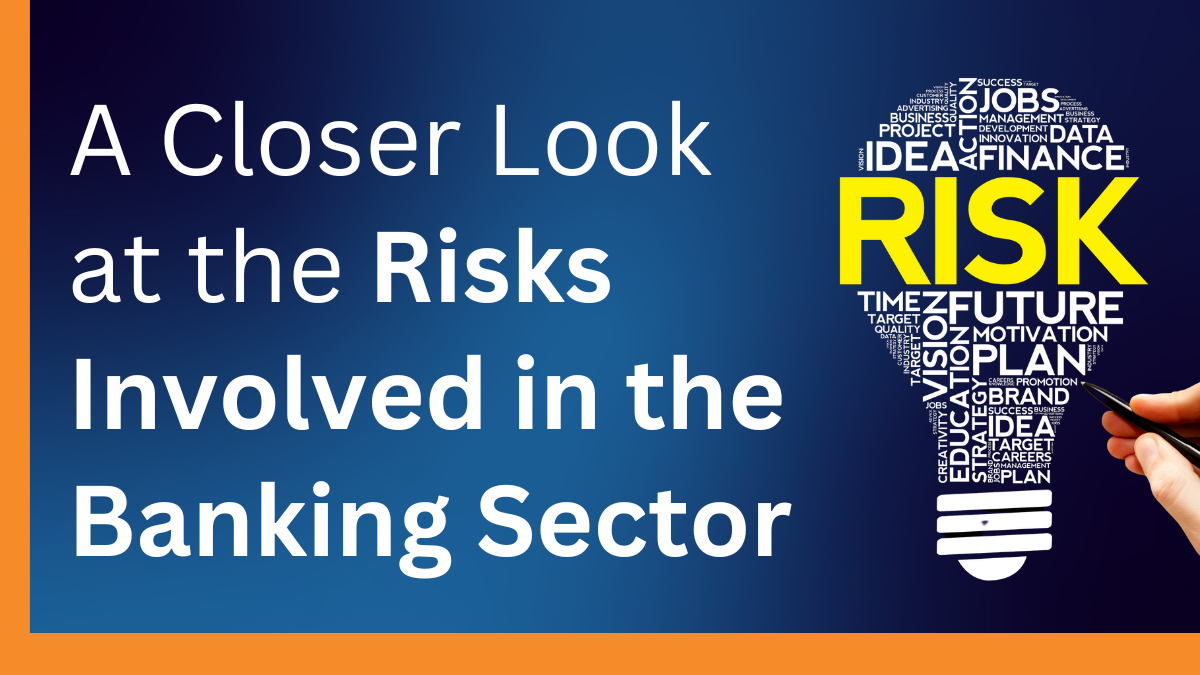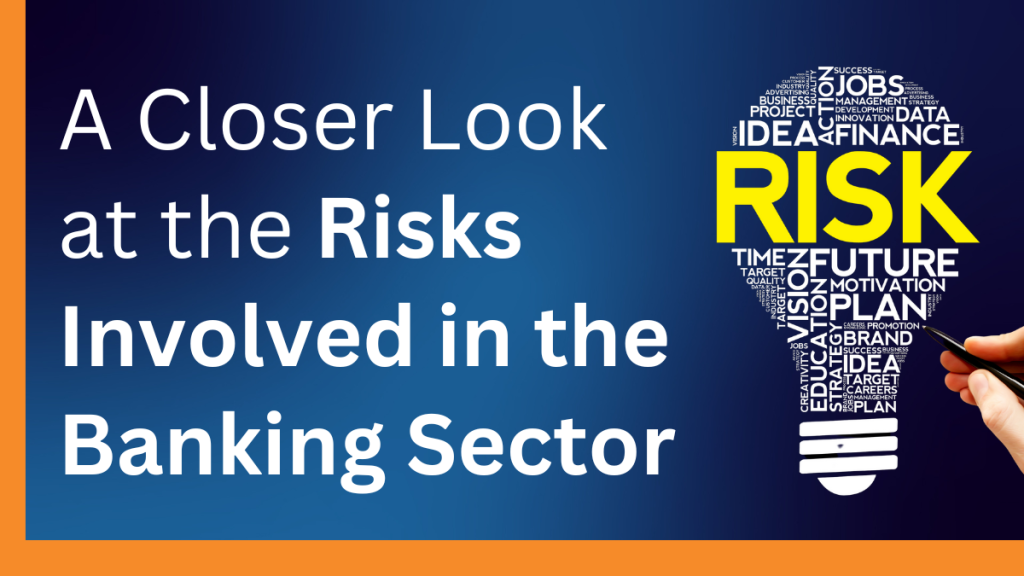The banking sector is important for both economic expansion and financial stability. Numerous risks that could impact this industry’s operations, profitability, and general stability do exist. For the upcoming banking and government exams like RBI Grade B, SEBI, NABARD, SBI PO, etc., major risks in the banking sector is one of the essential topic to glance on. Comprehending these risks is not only beneficial for applicants during written assessments but also essential for the interview.
In this blog, we are going to provide you with thorough knowledge about the risks involved in the banking sector and many other relevant and essential information about it. So, we recommend you read this blog till the end.

What are Banking Risks?
Banks face risks that could significantly affect their operations and position. Events in the financial markets or the wider economy, whether anticipated or not, can trigger these risks. Additionally, risk may arise from internal factors such as employee negligence or fraud, which may reduce the value of the fund by reducing asset values. Such risks could result in loss of revenue, damage to the bank’s reputation and diminished customer confidence. Manage these risks effectively to maintain the financial health of the bank, ensure it can meet its obligations, remain efficient and protect the interests of stakeholders. Without proper risk management, a fund’s profitability and long-term viability can be severely compromised.
Types of Risks in the Banking Sector
A wide range of risks can significantly affect the banking industry’s operations, financial stability, and overall performance. Maintaining a stable and robust banking system requires an understanding of these risks and effective risk management. The following is a summary of the main dangers facing the banking industry, along with explanations:
Liquidity Risk
When short-term obligations are used to finance long-term assets, banks run the risk of having trouble refinancing or rolling over those liabilities. This risk includes the possibility that an organization won’t be able to pay its maturing debts, or that it will only be able to do so by taking out expensive loans or selling its assets for a substantial discount. There are various ways that banks’ liquidity risk presents itself.
Funding Liquidity Risk:
The risk associated with funding liquidity is the difficulty in obtaining capital to meet cash flow obligations. This problem arises when net outflows from unanticipated withdrawals or from retail and wholesale deposit non-renewals must be covered.
Time Risk:
When performing assets become non-performing, there is a need to make up for the expected lack of capital inflows, which leads to time risk.
Call Risk:
The realization of contingent liabilities gives rise to call risk. It may also happen if a bank is unable to take advantage of lucrative business possibilities when they present itself.
Interest Rate Risk
Interest rate variations that impact an institution’s Net Interest Margin or Market Value of Equity (MVE) are known as Interest Rate Risk (IRR). IRR can be viewed from two angles: either as a way to measure the impact on the bank’s earnings, or as a way to measure the impact on the economic value of the bank’s holdings off the balance sheet (OBS) and assets and liabilities.
Gap or Mismatch Risk:
Having assets, liabilities, and Off-Balance Sheet items with different principal amounts, maturity dates, or re-pricing dates results in gap or mismatch risk. Due to this circumstance, the institution is vulnerable to unanticipated changes in market interest rates.
Basis Risk:
When different assets, liabilities, and off-balance sheet items’ interest rates fluctuate to different degrees, basis risk arises.
Embedded Options Risk:
Significant changes in market interest rates can be risky for banks because they can lead to premature withdrawals from term deposits before they mature, early repayment of demand and cash credit loans, and the exercise of call and put options on bonds and debentures.
Reinvested Risk:
The uncertainty surrounding the interest rate at which future cash flows may be reinvested gives rise to reinvestment risk.
Net Interest Position Risk:
Position with Net Interest When market interest rates fall and banks have more generating assets than liabilities to pay, risk arises. In these situations, banks see a gain in Net Interest Income (NII) when interest rates rise and a decrease in NII when market interest rates fall.
Market Risk
Market risk is the possibility that, as transactions are being liquidated, market movements will result in unfavorable changes to the trading portfolio’s mark-to-market value. This risk results from unfavorable changes in the level or volatility of the prices of interest rate instruments, stocks, commodities, and currencies.
Forex Risk:
Forex risk is the chance that a bank holding an open position—either spot, forward, or a mix of both—in a particular foreign currency will lose money as a result of adverse changes in exchange rates.
Market Liquidity Risk:
When a bank finds it difficult to complete a large transaction for a particular instrument at or near the going rate, it is said to be exposed to market liquidity risk.
Operational Risk
Operational risk, according to the Basel Committee for Banking Supervision, is defined as the possibility of suffering a financial loss as a result of inadequate or broken internal procedures, staff, and systems, as well as outside events. As a result, the three main sources of exposure for operational losses are people, processes, and technology systems.
Transaction Risk
It is caused by either dishonest behavior, inefficient company practices, or an inability to maintain operations and manage data effectively.
Compliance Risk
Compliance risk is the possibility that a bank will not follow applicable laws, regulations, codes of conduct, and standards of ethical practice, which could result in legal ramifications, financial losses, or reputational harm. Because of the strong correlation between a bank’s reputation and its adherence to ethical standards and fair practices, it is often referred to as integrity risk.
Strategic Risk
Strategic risk arises when banks make poor business decisions, fail to execute their policies effectively, or fail to adapt to industry changes. This risk is closely related to the good alignment of business plans, resource allocation and capacity
Reputation Risk
Reputational risk occurs when a bank’s public image deteriorates, potentially resulting in legal problems, bankruptcy, or a decline in customers. This risk is all about maintaining a positive public perception.
An Overview of the Risk Management in India
Risk management involves controlling uncertainties, risks, challenges and errors. Here’s how to understand and manage these things.
Uncertainty: This occurs when the outcome is unpredictable due to lack of information. As more information is gathered, uncertainty can turn into danger.
Risk: Once consequences can be calculated, risk management strategies can be implemented to mitigate these risks.
Undetermined: Occurs when there are contradictions and ambiguous decisions.
With an ever-changing market, banks in India have to stay updated of regulatory frameworks, international accounting standards and changes in customer service. It is therefore important for banks to follow the risk management guidelines issued by the Reserve Bank of India (RBI) and the Bank for International Settlements (BIS).
Involvement of RBI in Risk Management in Banks
The Reserve Bank of India (RBI) uses the CAMELS rating system to assess the financial health of banks. The system looks at six key areas: capital adequacy, asset quality, performance, earnings efficiency, liquidity, and market risk sensitivity.
CAMELS Framework Components
Capital Adequacy (C): Checks if the bank has enough capital by looking at capital trends, risk management, economic conditions, loan quality, and growth plans.
Asset Quality (A): Evaluates the quality of the bank’s loans.
Management (M): Looks at how well the bank manages financial pressures.
Earnings (E): Assesses if the bank can generate enough returns to grow, stay competitive, and strengthen its capital.
Liquidity (L): Measures how easily the bank can convert short-term assets into cash.
Sensitivity (S): Examines how specific risks affect the bank by looking at how it manages credit concentrations.
CAMELS Rating
Rating 1: Best
Rating 5: Worst
The Basel Committee on Banking Supervision introduced this system in 1988 as a standard for evaluating banks. The RBI follows these guidelines to ensure banks are stable and well-managed.
Objectives of Risk Management in the Banking Sector
The main objective of risk management in the banking sector is to enhance profitability for stakeholders by increasing profitability and efficient use of capital. This gives the bank long-term financial stability and solvency.
Enhancing Value Proposition
Risk management practices aim to maximize returns while protecting the bank’s assets. By taking calculated risks and implementing effective mitigation strategies, banks can generate sustainable returns. This balanced approach contributes to a stable financial environment, which benefits all stakeholders, including shareholders, customers and employees.
Optimizing Capital Allocation
Efficient capital allocation is critical to the growth and stability of a bank. Appropriate risk management ensures that capital is allocated to areas where the best returns and risk can be managed. This efficient use of capital supports the bank’s strategic objectives and enhances its competitive advantage.
Ensuring Long-Term Stability
Prudent risk management is essential for the long-term stability of stock markets. By continuously monitoring and managing risks, banks can avoid major financial setbacks and ensure growth stability. This consistency attracts investors and builds consumer confidence.
Balancing Risk and Reward
A key aspect of risk management is finding the right balance between risk exposure and risk mitigation. To maximize returns, banks need to take on more risk but also implement strategies to minimize potential losses. This balance is necessary to generate profitability and maintain a strong economic foundation.
Conclusion
Understanding and managing risks in the banking sector is critical to maintaining financial stability and profitability. Effective risk management helps banks protect assets, optimize capital allocation, and ensure long-term stability. By balancing risk and reward, banks can generate sustainable returns and build stakeholder trust. A strong understanding of these concepts is important for candidates preparing for competitive exams like RBI Grade B, SEBI, NABARD, SBI PO. These skills are not only helpful in writing exams but also important in interviews. Become informed, prepared, and well-prepared to address questions on this important topic.
To help you prepare 50% faster for competitive exams, ixamBee provides free Mock Test Series and all the Current Affairs in English and Current Affairs in Hindi in the BeePedia capsules for GA Preparation. You can also get the latest updates for Bank PO, Bank Clerk, SSC, RBI Grade B, NABARD, and Other Government Jobs.
